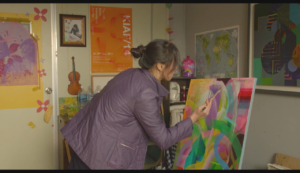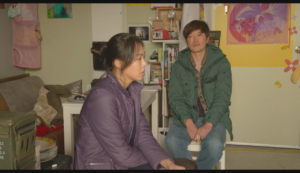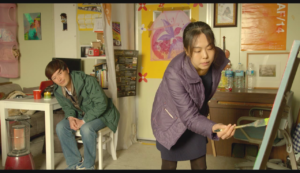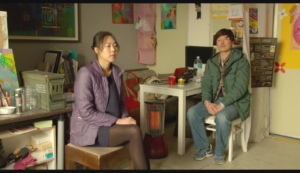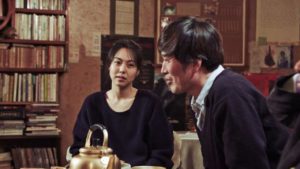 Review: One Night Only
Review: One Night Only
Right Now, Wrong Then | Hong Sang-soo | South Korea | 2015 | 121 min
Union South Marquee Theater, Thursday, May 5, 9:30pm»
James Kreul looks at Korean director Hong Sang-soo’s latest take on the “forking-path” parallel universe trope, Right Now, Wrong Then, and argues that the minimalist style pays off when it throws into relief several changes in emotional beats.
The WUD Film Committee will end its semester with a strong week of films at the Union South Marquee Theater. In addition to popular entertainments like Jackie Chan’s Police Story (1985) and the recent Deadpool, WUD Film will screen new international cinema including Icelandic director Grimur Hakonarson’s Rams and Korean Hong Sang-soo’s Right Now, Wrong Then.
Hong’s Right Now, Wrong Then, screening once on Thursday, May 5 at 9:30pm, is a particularly interesting choice in contrast to the hyperkinetic Police Story and Deadpool. Hong’s film is dominated by extended long takes with minimal camera and character movement, and on the surface the narrative is not much more complicated than an extended meet-cute. Despite the lack of visual spectacle, Hong maintains our interest in part due to the seemingly effortless charm of the actors; Jung Jae-young won Best Actor at the Locarno International Film Festival and the film took the top prize, the Golden Leopard.
At the half-way mark, however, we discover that the simplicity of the story serves a more complicated purpose, as Hong backs up to re-imagine and re-tell the story. David Bordwell has written at length about the “forking path” narrative in cinema, and also has written frequently about Hong’s use repetition and variation in his films.
In a sense telling you that the story repeats is a bit of a spoiler, unless you are familiar with Hong’s previous films: Bride Stripped Bare by Her Bachelors (2000), Hahaha (2010), and Nobody’s Daughter Haewon (2014, reviewed at Madison Film Forum by Jake Smith). The opening title card gives a clue, titling part one as “Right Then, Wrong Now.” But knowing that the second half will repeat does not ruin the experience, because the cumulative emotional changes in part two, “Right Now, Wrong Then,” are even more interesting and satisfying than the big plot changes.
Seoul-based film director Ham Cheon-soo (Jung) visits Suwon to screen one of his films and answer audience questions. The day before the screening, he finds diversions in Suwon with his crew member Yeom Bo-ra (Ko Ah-sung, whom some will recognize from Snowpiercer) before deciding to visit the museum at Hwaseong Haenggung palace alone. He had noticed a young woman entering the palace earlier, and when she sits next to him her day-long presence there surprises him. Her name is Yoon Hee-jeong (Kim Min-hee), a young painter who agrees to have coffee with Cheon-soo. This begins a low-key series of events as the two decide to spend the rest of the day together. Cheon-soo’s occasional voice over comments on Bo-ra, Hee-jeong, and how he remembers the day going.
Some changes in part two are large, other changes are small. First, the voice over is eliminated, so we only have access to Cheon-soo’s emotions and subjective responses through visible, external cues. Second, some important story events, such as the subplot with Yeom Bo-ra, are either eliminated or severely ellipsized. While the basic trajectory of Cheon-soo’s day with Hee-jeong remains the same (similar locations, similar conversation topics) all the changes cumulatively result in a significantly different outcome in their brief relationship.
Each scene is a master class in very concise staging, camera placement, and performance. While the camera for the most part remains in one position in each scene, there is a degree of scene dissection through pans and very bizarre, not-quite-smooth zooms. Changes in camera position, angle, and lens length carry a great deal of weight when comparing repeated scenes.
When Cheon-soo and Hee-jeong visit her painting studio the first time, the camera tilts up as her hand takes a brush with some paint and it follows the brush to the nearly-finished canvas. The camera then pans left with her as she sits down. From this vantage point, we get a profile of Hee-jeong but a straight-on view of Cheon-soo. After a slight reframing zoom-in, we are in a perfect position to contemplate Cheon-soo as he longingly glances at Hee-jeong, and his voice over reinforces his attraction to her.
In the second version, Hong positions the camera on the other side of the canvas, so we do not see the painting at all. Small change: Hee-jeong’s paint has changed from orange to green. Big change: we have access to Cheon-soo watching her paint, but not to his voice over. The emotional beats of the scene also change, as the dialogue focuses on Cheon-soo’s critique of the painting and Hee-jeong’s reaction to his words (we’re not sure if he’s critiquing the same painting we’ve seen). Just as we were in the perfect position to observe Cheon-soo the first time around, here we are in the perfect position to observe Hee-jeong’s slow burn.
In the painting studio scenes these changes are more obvious. In other scenes, the changes start messing with your head because, as David Bordwell has suggested, we’re not always that good at remembering narrative details. But as we do realize that Cheon-soo and Hee-jeong share significant information at different places in the broad narrative, the changes begin to have an emotional impact because we know what significance that information might have for their relationship in subsequent scenes.
Despite the basic repetitions in locations and scenarios, the second half somehow seems more fresh and vibrant than the first half. This could be because Hong plays more with subtext and extended scene durations in the first half, but more directly confronts emotional beats within more concise scenes in the second half.
The two halves are not conceived as “good” or “bad” outcomes to the basic story, like Run Lola Run or several other forking-path narratives. They are simply two different outcomes, which elicit different emotional responses. That said, the second half is far more satisfying, perhaps because those emotional beats play out more explicitly within the scene work.
Watching Right Now, Wrong Then this week also satisfies the urge to take in at least one more deliberately paced, emotionally and intellectually satisfying art film before the summer blockbusters hit town.
